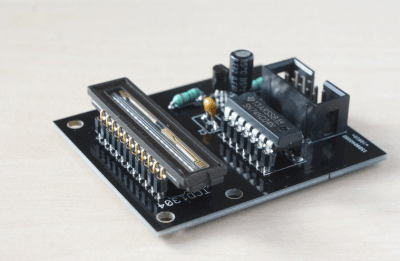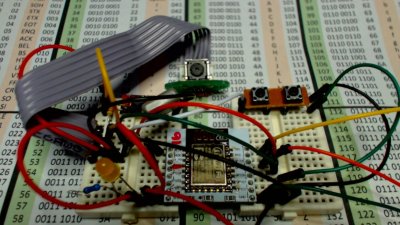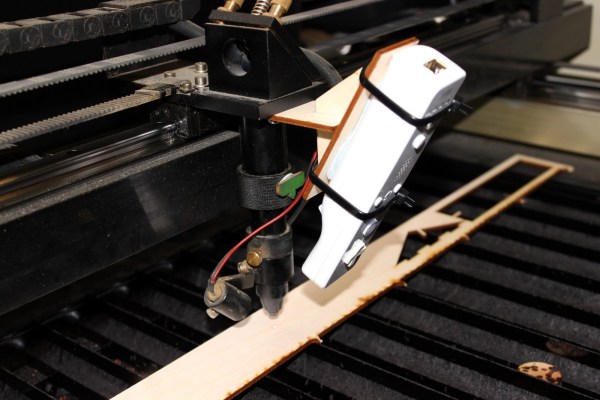[youtube=http://www.youtube.com/watch?v=MD_-YnFZFP8&hl=en]
I found this while looking for a teardown of a Wii Nunchuck remote since they’re cheap and include a 3 axis accelerometer. I mentioned an interface board the other day, but the responsiveness of the interface in this video grabbed my attention. If you like it, you should check out this [via] Nunchuck Arduino RF controlled robot. You can find details on that bot here. The accelerometer itself only runs about $10, but it’s a pretty small SMD part.
Retrotechtacular: The TV Bombs Of WWII
Anyone who was around for the various wars and conflicts of the early 2000s probably recalls the video clips showing guided bombs finding their targets. The black-and-white clips came from TV cameras mounted in the nose of the bomb, and were used by bombardiers to visually guide the warhead to the target — often providing for a level of precision amounting to a choice of “this window or that window?” It was scary stuff, especially when you thought about what was on the other side of the window.
Surprisingly, television-guide munitions aren’t exactly new, as this video on TV-guided glide bombs in WWII indicates. According to [WWII US Bombers], research on TV guidance by the US Army Air Force started in 1943, and consisted of a plywood airframe built around a standard 2000-pound class gravity bomb. The airframe had stubby wings for lift and steerable rudders and elevators for pitch and yaw control. Underneath the warhead was a boxy fairing containing a television camera based on an iconoscope or image orthicon, while all the radio gear rode behind the warhead in the empennage. A B-17 bomber could carry two GB-4s on external hardpoints, with a bulky TV receiver provided for the bombardier to watch the bomb’s terminal glide and make fine adjustments with a joystick.
In testing, the GB-4 performed remarkably well. In an era when a good bombardier was expected to drop a bomb in a circle with a radius of about 1,200′ (365 meters) from the aim point, GB-4 operators were hitting within 200′ (60 meters). With results like that, the USAAF had high hopes for the GB-4, and ordered it into production. Sadly, though, the testing results were not replicated in combat. The USAAF’s 388th Bomber Group dropped a total of six GB-4s against four targets in the European Theater in 1944 with terrible results. The main problem reported was not being able to see the target due to reception problems, leaving the bombardiers to fly blind. In other cases, the bomb’s camera returned a picture but the contrast in the picture was so poor that steering the weapon to the target was impossible. On one unfortunate attack on a steel factory in Duren, Germany, the only building with enough contrast to serve as an aiming point was a church six miles from the target.
The GB-4’s battlefield service was short and inglorious, with most of the 1,200 packages delivered never being used. TV-guided bombs would have to wait for another war, and ironically it would be the postwar boom in consumer electronics and the explosion of TV into popular culture would move the technology along enough to make it possible.
Tiny Arduino Drone Even Has An FPV Camera
In the turmoil of today’s world, drones are getting bigger, badder, and angrier. [Max Imagination] has gone the other way with his work, though, building a teeny Arduino drone that can fit in the palm of your hand. Even if you have a small hand!
The drone is based around an Arduino Pro Mini, and uses an MPU6050 IMU for motion sensing and flight control. Communication with the drone is via an NRF24L01. Four small coreless motors are used for propulsion, driven by tiny MOSFETs, and the whole assembly is run via a teeny 220 mAh lithium-polymer battery. Oh, and there’s an FPV camera so you can put on some goggles and see where it’s going!
Control is via MultiWii software, written specifically for building multirotor craft. [Max] flies the craft using a controller of his own creation, again using an NRF24L01 for communication.
It’s a neat build, and a titchy one too! Tiny drones have a character all their own, even if they can’t really stand up to windier outdoor environments. Video after the break.
Continue reading “Tiny Arduino Drone Even Has An FPV Camera”
WiiBoy Color Is Exactly What It Sounds Like
Anyone can go out and buy a handheld console, and if you want to be the cool kid on the school bus, you can always ask your parents to take you out to get one. But if you want real street cred that lasts through your adult years, you’ve gotta put something together yourself. [GingerOfMods] has done just that with the Wiiboy Color.
Yes, it’s another home-console-turned-portable, and it’s perfomed with exquisite execution. The Wii motherboard is cut and sliced to the absolute bare minimum, as the aim was to build the entire system to the rough form factor of the original Game Boy Color. Custom PCBs were then used to link the chopped ‘board to peripherals, such as the USB drive used to load games and the circuitry from a Gamecube controller. The screen is a beautiful looking 3.5″ IPS LCD, running at 480p and originally intended for use as an automotive backup camera. Battery life is around 2-3 hours, with a USB-C port included for easy charging. More details are included on the forum build log.
It’s a tidy build, and the 3D printed case, Switch joysticks and DS Lite buttons give it a near-production quality finish. [GingerOfMods] intends to build more for commissions, though expect a hefty price tag given the labor and custom work involved. We’ve seen other portable Wiis before too, like this tightly-packed Kapton-heavy build. Video after the break.
Continue reading “WiiBoy Color Is Exactly What It Sounds Like”
Hacklet 97 – Camera Projects
We last covered camera projects way back in Hacklet #11. A ton of camera projects have been added to Hackaday.io since then. While the rest of the world is taking selfies, hackers, makers, and engineers have been coming up with new ways to hack their image capture devices. This week on the Hacklet, we’re taking a look at some of the best camera projects on Hackaday.io!
![]() First up is [aleksey.grishchenko] with PiXel camera. PiXel is a camera and a live video display all in one, We wouldn’t exactly call it high-definition though! A Raspberry Pi uses its camera module to capture images of the world. [Aleksey] then processes those images and displays them on a 32 x 32 RGB LED matrix. This matrix is the same kind of tile used in large outdoor LED signs. The result is a surreal low resolution view of the world. Since the Pi, batteries, and camera all hide behind the LED matrix, there is an unobstructed view of the world around you. [Aleksey] used [Henner Zeller’s] matrix library to make this hack happen.
First up is [aleksey.grishchenko] with PiXel camera. PiXel is a camera and a live video display all in one, We wouldn’t exactly call it high-definition though! A Raspberry Pi uses its camera module to capture images of the world. [Aleksey] then processes those images and displays them on a 32 x 32 RGB LED matrix. This matrix is the same kind of tile used in large outdoor LED signs. The result is a surreal low resolution view of the world. Since the Pi, batteries, and camera all hide behind the LED matrix, there is an unobstructed view of the world around you. [Aleksey] used [Henner Zeller’s] matrix library to make this hack happen.
 Next up is [Esben Rossel] with Linear CCD module. [Esben] is building a Raman spectrometer, much like 2014 Hackaday Prize finalist [fl@C@] with his own ramanPi. The heart of a spectrometer is the linear image capture device. Both of these projects use the same TCD1304 linear CCD. Linear Charge Coupled Devices (CCDs) are the same type of device used in flatbed document scanners. The output of the CCD is analog, so an ADC must be used to capture the data. [Esben] is using an STM32F401RE on a Nucleo board as the control logic. The ST’s internal ADC converts the analog signal to digital. From there, it’s time to process all the spectra.
Next up is [Esben Rossel] with Linear CCD module. [Esben] is building a Raman spectrometer, much like 2014 Hackaday Prize finalist [fl@C@] with his own ramanPi. The heart of a spectrometer is the linear image capture device. Both of these projects use the same TCD1304 linear CCD. Linear Charge Coupled Devices (CCDs) are the same type of device used in flatbed document scanners. The output of the CCD is analog, so an ADC must be used to capture the data. [Esben] is using an STM32F401RE on a Nucleo board as the control logic. The ST’s internal ADC converts the analog signal to digital. From there, it’s time to process all the spectra.
 [Chiprobot] brings the classic Wii remote camera to the internet of things with
[Chiprobot] brings the classic Wii remote camera to the internet of things with
ESP8266 meets Wii Mote Camera. The Wii remote uses a camera which doesn’t output images, instead it plots the location of up to four IR LEDs. Normally these LEDs are located in the poorly named sensor bar that is sold with the Wii. Hackers have been using these cameras in projects for years now. [Chiprobot] paired his camera with the modern classic ESP8266 WiFi module. The ‘8266 is programmed to read data from the camera’s I2C bus. It then sends the data as an SVG request to the W3C website. W3C returns a formatted image based on those coordinates. The resulting image is a picture of the IR LEDs seen by the camera. Kind of like sending your negatives out to be developed.
 Finally, we have [GuyisIT] with Raspberry Pi Photobooth. Photo booths are all the rage these days. First it was weddings, but now it seems like every kids party has one. [GuyisIT] didn’t rent a booth for his daughter’s birthday, he built one using his Raspberry Pi and Pi camera. The project is written in python, based upon [John Croucher’s] code. When the kids press a button, the Pi Snaps a series of pictures. The tiny Linux computer then joins and rotates the images while adding in some superhero themed graphics. Finally the Pi prints the image on to a photo printer. The biggest problem with this hack is re-triggering. The kids loved it so much, they kept pressing the big red button!
Finally, we have [GuyisIT] with Raspberry Pi Photobooth. Photo booths are all the rage these days. First it was weddings, but now it seems like every kids party has one. [GuyisIT] didn’t rent a booth for his daughter’s birthday, he built one using his Raspberry Pi and Pi camera. The project is written in python, based upon [John Croucher’s] code. When the kids press a button, the Pi Snaps a series of pictures. The tiny Linux computer then joins and rotates the images while adding in some superhero themed graphics. Finally the Pi prints the image on to a photo printer. The biggest problem with this hack is re-triggering. The kids loved it so much, they kept pressing the big red button!
If you want to see more camera projects, check out our updated camera projects list! If I missed your project, don’t be shy! Just drop me a message on Hackaday.io. That’s it for this week’s Hacklet. As always, see you next week. Same hack time, same hack channel, bringing you the best of Hackaday.io!
Wii-Motified Laser Cutter Refocuses For Contoured Cutting
Still laser cutting all of your parts in 2D? Not the folks over at [Just Add Sharks]. With a few lines of code and an in-tact Wii-Mote, they’ve managed to rig their laser cutter to dynamically refocus based on the height of the material.
The hack is cleanly executed by placing the Wii-Mote both at a known fixed distance-and-angle and within line-of-sight of the focused beam. Thankfully, the image-processing is already done onboard by the Wii-Mote’s image sensor, which simply returns the (x,y) coordinates of the four brightest IR points in view. As the beam moves over the material, the dot moves up or down in the camera’s field-of-view, triggering a refocus of the laser as it cuts. Given that the z-axis table needs to readjust with the contour, the folks at [Just Add Sharks] have slowed down the cutting speed. Finally, it’s worth noting that the Wii-Mote was designed to detect IR LEDs, not a 10600-nanometer laser beam, but we suspect that the Wii-Mote is receiving colors produced by the fluorescing material itself, not the beam. Nevertheless, the result is exactly the same–a dynamically refocusing laser!
Now that [Glowforge] has released a continuously-refocusing laser cutter implemented with stereoscopic cameras, it’s great to see the community following in their footsteps with a DIY endeavor. See the whole system in action after the break!
Continue reading “Wii-Motified Laser Cutter Refocuses For Contoured Cutting”
Oculus Rift And Wii Balance Board Make Hoverboards A (Virtual) Reality
It’s almost 2015 and still don’t have the futuristic technology promised to us by Back to the Future Part II. Where are the flying cars, Mr. Fusions, or 19 Jaws movies? Most importantly, where are our hoverboards?
[cratesmith] got tired of waiting around and decided to take matters into his own hands. He combined the Oculus Rift virtual reality headset with the Wii Fit Balance Board to create a virtual hoverboard experience. He used the Unity3D engine (a favorite among Rift developers) to program the game engine. It’s a very rough demo right now, but the game comes complete with a simulated town to float around in and of course includes a model DeLorean.
Before you try to play this demo, you should know that it’s not without its faults. The primary problem [cratesmith] has experienced is with simulation sickness. His virtual reality system has no way to track body motion, which means that leaning back and forth on the Wii Fit board does not get translated to the equivalent virtual movement. The game must assume that the player stands straight up at all times, which is not an intuitive way to control something similar to a skateboard. The result is an off-putting experience that can break immersion and lead to a feeling of nausea.
A possible solution to this problem would be to use a camera style motion detector like the Microsoft Kinect. In fact, another Reddit user has recently posted a teaser video of another hoverboard simulator that uses the Oculus Rift, Wii Fit Board, and Kinect. Not much information is available about this second project, but we look forward to seeing updates in the future.
[createsmith] has not published the code for his demo because it’s still in the very early stages, but he has stated that he’s been giving it out to anyone who goes out of their way to ask. The hoverboard is probably the most coveted fictional technology from the 1989 adventure film. We know this because we’ve seen multiple projects over the years that were inspired by the movie. We’re excited to see it come to fruition in any form.
[via Reddit]
















